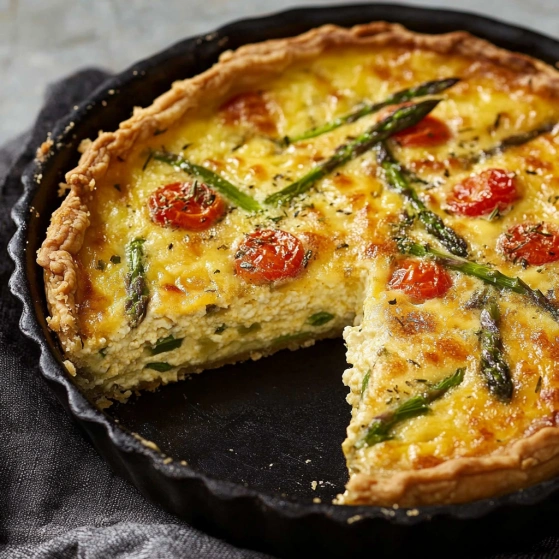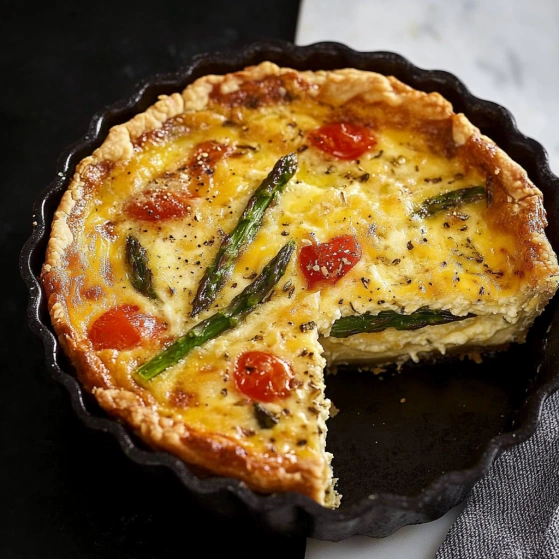 Pin it
Pin it
This rustic cast-iron cheesy asparagus quiche combines seasonal vegetables with a buttery, no-roll crust that forms right in the pan. It's become my Sunday brunch centerpiece whenever asparagus is in season, creating both a beautiful presentation and delicious meal in one versatile skillet.
I first created this quiche when hosting an impromptu brunch and needed something that looked fancy but used what I had on hand. My mother-in-law asked for the recipe before she even finished her first slice and now it's requested at every family gathering.
Ingredients
- All purpose flour: creates a tender buttery crust that forms right in the pan
- Unsalted butter: provides richness and helps create the sandy texture needed for the perfect crust
- Asparagus: adds seasonal freshness and a pop of color choose bright green firm stalks
- Sharp cheddar cheese: gives bold flavor look for aged varieties for more complexity
- Cherry tomatoes: offer sweet juicy bursts of flavor and beautiful color contrast
- Parmesan cheese: adds nutty depth and helps crisp the crust edges
- Half and half: creates the perfect custard texture without being too rich or too thin
- Eggs: bind everything together while creating a silky texture
Step-by-Step Instructions
- Prepare the asparagus:
- Sauté asparagus pieces in olive oil with salt and pepper until bright green but still firm. The goal is to slightly soften them while maintaining their structure. This quick cooking prevents them from releasing excess moisture into your quiche.
- Create the skillet crust:
- Melt butter in the still-warm cast iron, then mix in flour, seasonings, baking powder and Parmesan until sandy. Add water and press the mixture evenly across the bottom and up the sides. This butter-rich dough forms a shortbread-like base that eliminates the need for rolling out pastry.
- Mix the custard filling:
- Whisk eggs with sour cream until completely smooth, then add half and half and seasonings. The sour cream adds tanginess and helps create a velvety texture that contrasts beautifully with the crisp crust.
- Layer and assemble:
- Scatter cheddar over the crust, arrange asparagus pieces, then sprinkle with remaining Parmesan. Pour the egg mixture carefully over everything. The layering technique ensures even distribution of ingredients through every slice.
- Add tomatoes and bake:
- Place halved cherry tomatoes cut-side up before baking for 45-50 minutes. Positioning them this way allows their juices to concentrate rather than making the quiche soggy, creating little pockets of intense tomato flavor throughout.
- Rest before serving:
- Allow the quiche to cool for at least 30 minutes. This resting period is crucial for the custard to fully set and flavors to meld together, resulting in clean, beautiful slices.
 Pin it
Pin it
The asparagus is truly what makes this dish special for me. I grow it in my backyard garden each spring, and this quiche has become our traditional way of celebrating the first harvest. My daughter who normally avoids vegetables eagerly helps pick and prep the asparagus knowing this quiche is the reward.
Make Ahead Options
This quiche reheats beautifully, making it perfect for busy households. You can bake it completely, cool, then refrigerate for up to three days. To reheat, cover with foil and warm in a 325°F oven for about 15 minutes until just heated through. The crust maintains its texture surprisingly well thanks to the cast iron cooking method and butter-rich dough.
Seasonal Adaptations
While asparagus shines in spring, this versatile recipe works year-round with seasonal swaps. Summer brings opportunities for zucchini and bell peppers, fall welcomes butternut squash and kale, and winter opens doors for leeks and spinach combinations. Keep the egg mixture and cheese quantities the same, but feel free to substitute about 2 cups of any vegetable combination that inspires you.
 Pin it
Pin it
Serving Suggestions
This quiche pairs beautifully with a simple arugula salad dressed with lemon and olive oil, creating a perfect balance to the rich, savory flavors. For brunch, serve alongside fresh fruit and crispy bacon. If serving for dinner, a light soup makes an excellent companion. A crisp white wine like Sauvignon Blanc complements the creamy texture and vegetable notes perfectly.
Cast Iron Care Notes
The beauty of this recipe lies partly in its cooking vessel. After serving, clean your cast iron by scraping gently with a spatula and wiping with a paper towel while still warm. If needed, use hot water and a brush, but avoid soap which strips seasoning. Dry thoroughly on a low burner and apply a thin oil coating. This maintenance ensures your pan develops an increasingly non-stick surface with each use, making future quiches even easier to serve.
Frequently Asked Questions
- → Can I substitute the asparagus with other vegetables?
Yes, you can replace asparagus with broccoli, spinach, bell peppers, or zucchini. Just ensure vegetables with high water content are pre-cooked to remove excess moisture before adding to the quiche.
- → What is half-and-half and what can I use instead?
Half-and-half is a dairy product that's equal parts whole milk and light cream. You can substitute with equal parts milk and heavy cream, or use just heavy cream for a richer texture, or whole milk for a lighter option.
- → Can I make this quiche ahead of time?
Absolutely! This quiche can be prepared a day in advance and refrigerated. Reheat covered with foil in a 325°F oven for 15-20 minutes, or until warmed through. It also freezes well for up to 3 months.
- → Why use a spatula instead of a knife to serve?
A spatula is recommended to avoid scratching the cast-iron skillet's seasoned surface. Metal knives can damage the pan's coating, affecting its non-stick properties and potentially contaminating food with metal particles.
- → I don't have a cast-iron skillet. Can I use another pan?
Yes, you can use a 10-inch pie dish or tart pan instead. The crust preparation will be similar, though you might need to adjust baking time slightly. Cast iron provides excellent heat retention and crust browning, but other ovenproof dishes will still produce delicious results.
- → How do I know when the quiche is done baking?
The quiche is done when the center is set (not jiggly) and the edges are golden brown. You can also insert a knife into the center - it should come out clean with no wet egg mixture attached.
